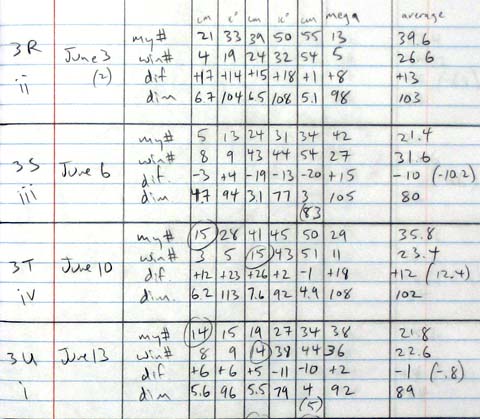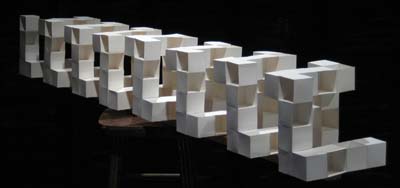Wall Text - Information Kiosk (Mor York)
note: The following text accompanied the installation "My Luck"
On display is a three-dimensional expression of my luck in relation to the Mega Million© lottery between May 4, 2007 and May 1, 2009.
My Luck consists of a string of distinct units, each a 6-sided polyhedron (with one face left open) with a unique shape associated with a particular lottery draw date. The measurements are arrived at by calculating the difference (+ or - ) between a randomly selected set of numbers ("Quick Pick") and the random set of winning numbers for that lottery draw. The design of each unit is built upon a given four-sided polygon, the leading face of the previous unit. A minimum of 7 measurements, angles and edge lengths, are required to complete the 6-faced polyhedron composed of 4-sided polygons. The six numbers of the lottery draw are therefore assembled into seven columns - an additional column calculated as an average number of the first five, but not the sixth (The Mega Million lottery numbers are arranged into two separate pools - five different numbers from 1 to 56 and the sixth number, called the "mega", from 1 to 46.). Columns 1, 2, 3, 5 and 6 provide measurements for angles (a figure subtracted or added to 90 degrees) and columns 4 and 7 become edge lengths (subtracted or added to 20 cm). In addition, the jackpot size for the corresponding draw date is calculated to be a scaling factor for each unit such that the larger the jackpot, the longer the edge length variables. (The estimated jackpot is never lower than 12 million, so I set 12 million to be at 1:1 scale. To make the rate of increased scale manageable, I set the scale to double when the jackpot had increased by 80 million [92 million minus the base jackpot of 12]). Each unit is essentially a distortion of a 20 cm cube built upon a previous cube, also distorted, so that distortion is compounded over the succession of units. Also, each successive unit takes a 1/4 turn of orientation from the previous unit to correct a directional pitch caused by the scaling factor. A face is left open to express the relative orientation of each unit. For each matching number that may occur between my random pick and the the winning set, I paint an exterior face of the corresponding unit white. Two matching numbers are two white faces, three for three, etc., always starting with the exterior face to the left of the open face (regarding the series with the succession of units extending upward). I started the entire series with a base unit - a 20 cm cube with all its exterior faces painted white - to serve as a point of origin. One can judge the effect of the distortion by using this base unit ("A", by the large window) for comparison. Had I won the lottery for every draw - all my "Quick Pick" numbers matching all winning numbers -
My Luck would have been a perfectly straight sequence of 20 cm cubes, all exterior faces painted white. However, the sculpture would still have been too long for the space, and as it happens the distortion that occurs following my design scheme also made it too large and erratic. To keep
My Luck as a continuous sequence, it was fitted to the space by having the sequence hinge back into the space when it would meet an obstruction. (There is only one exception where the sequence is interrupted by a gap because a hinge was unmanageable).
My Luck may be "read" from its base unit by the gallery's large window to where it ends overhead at the west wall of the foyer.
Cell Clusters
| note: The following, very similar to the text above, is written for a similar piece, and is actually meant to be legible. |
|
detail from "Helical" project notebook
 |
|
"Helical Cluster - Armory" consists of a set of distinct units. Each unit, a 6-sided polyhedron with one face left open, has a unique shape associated with a unique lottery ticket of a particular Mega Millions Lottery draw date. The measurements are arrived at by calculating the difference (+ or - ) between my randomly selected set of numbers (a "Quick Pick") and the random set of winning numbers for that lottery draw. A face was painted white to indicate when matching numbers occured. Each unit is essentially a distortion of a 25 cm cube built upon a previous cube, also distorted, so that distortion is compounded over the succession of units. The units are arranged in a sequence based on a helix. This pattern was chosen to suit the Armory site, a long and narrow walkway but also because it carries with it the suggestion of a DNA strand. In this case, however, the coded information of my helix is distorted with random "noise" which is at the core of my system of construction. This is an essential characteristic of the work which is shared by other pieces in this series such as the "Cube" and "Tri-Hexihedron" clusters. Mis-information is the principal generating the form, similar to the growth of cancer cells or the irregular clumps of perfectly shaped crystals. |
My aim here is to relinquish direct control over the emerging shape. The object finds its own way following a set of parameters that use the aimlessness of random numbers as its source. It grows naturally, or un-naturally, depending on your view of nature. |
maquette (1:5) for helical pattern
 |
|
january 2009

